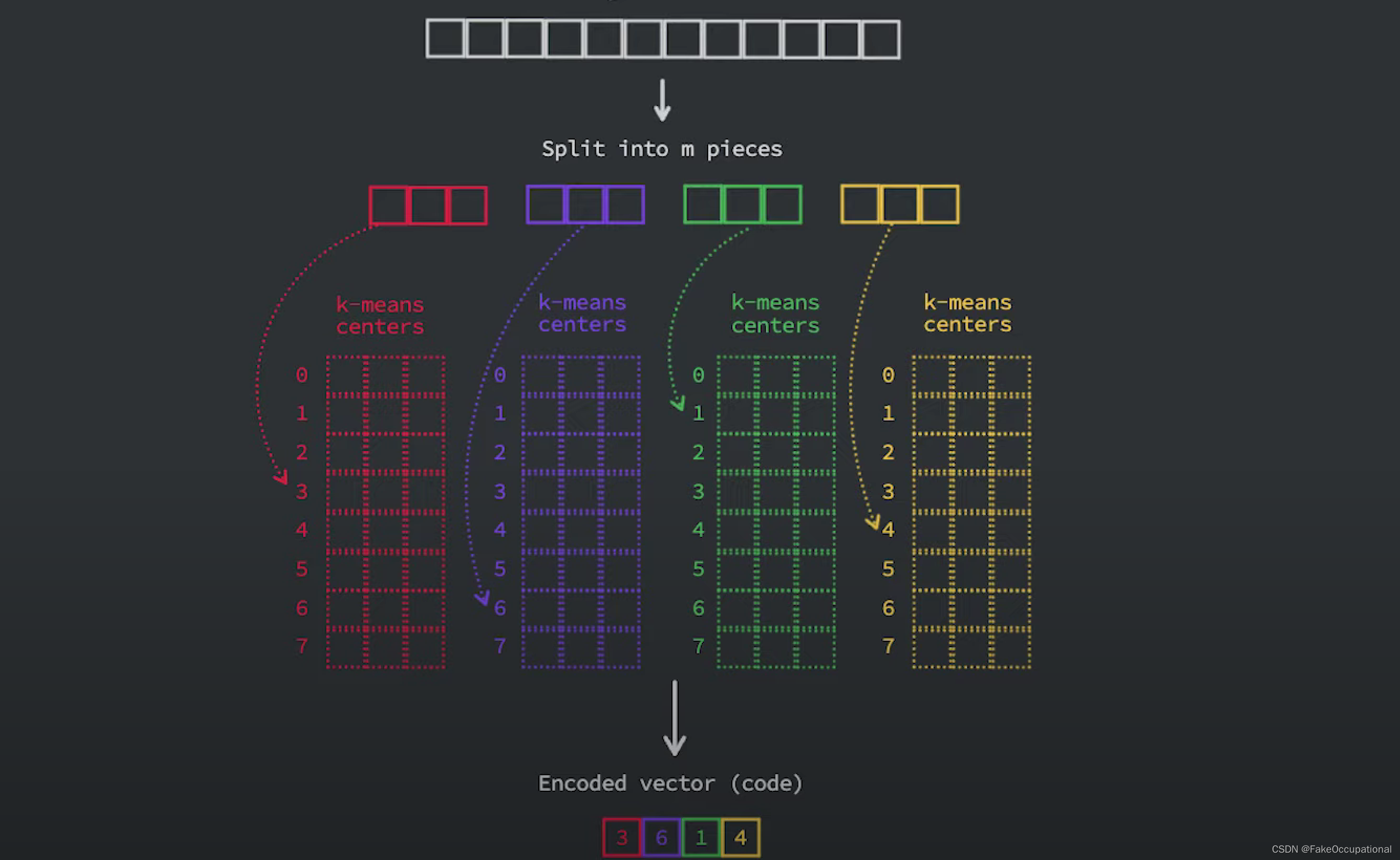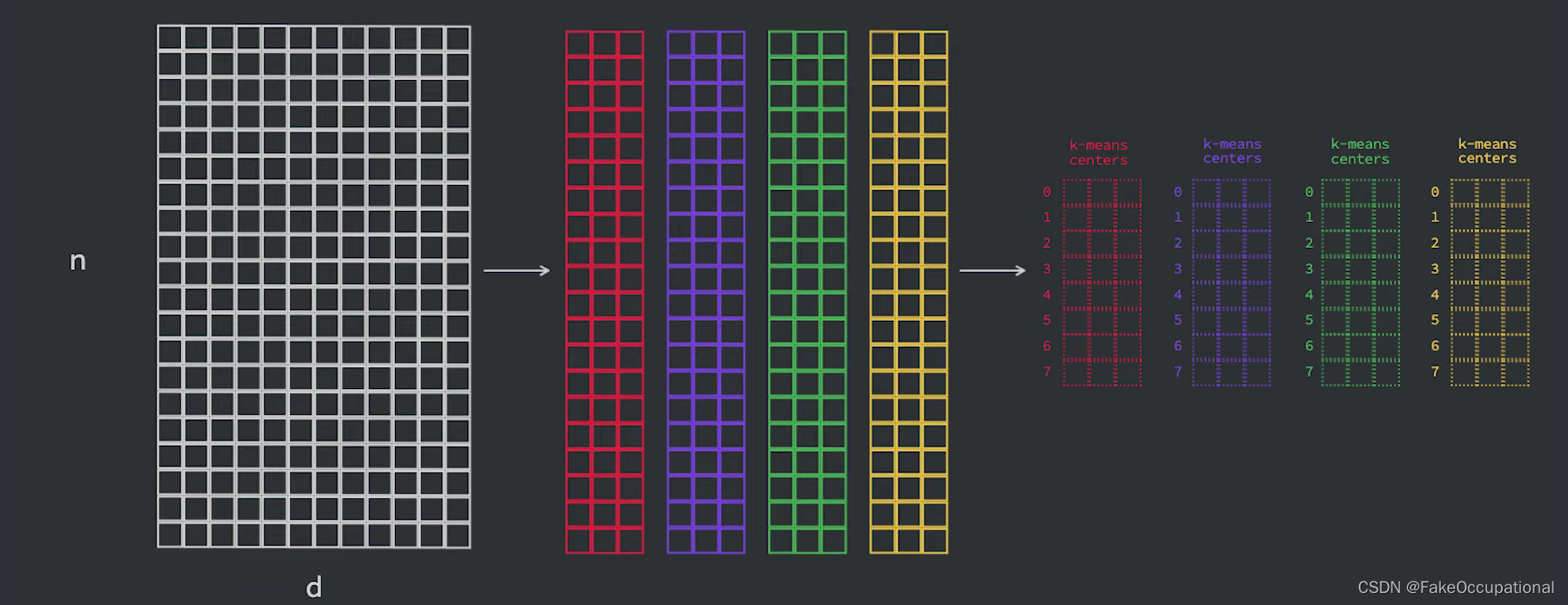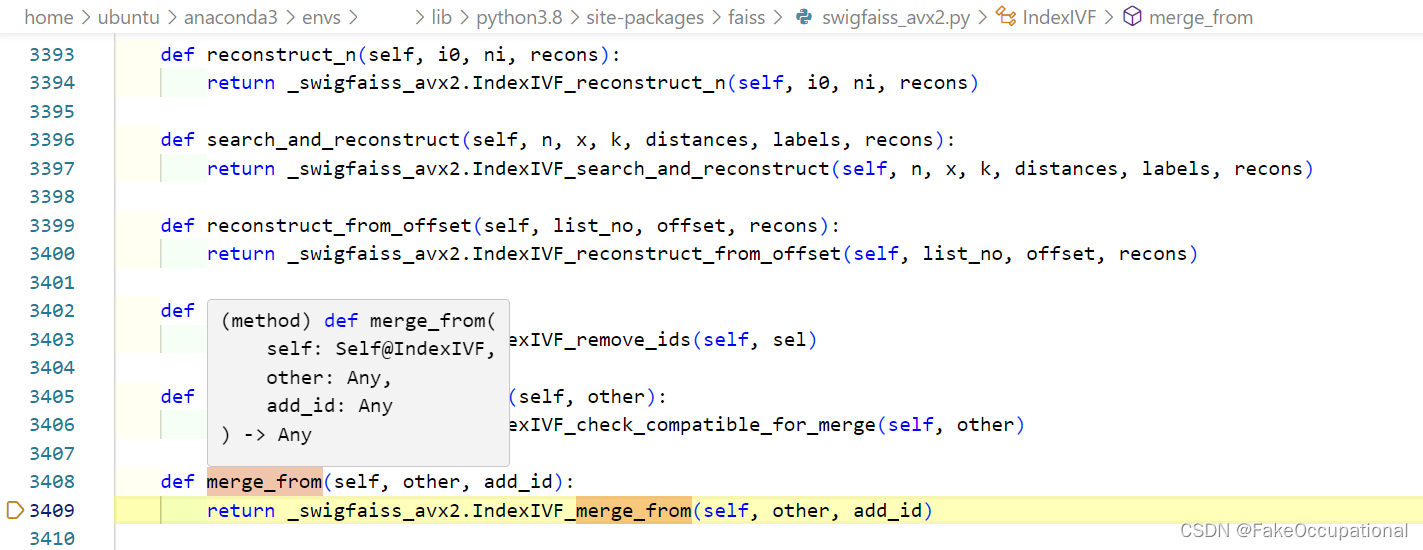向量数据库:faiss的常用三种数据索引方式(IndexFlatL2,IndexIVFFlat,IndexIVFPQ)的使用和持久化+索引融合的实现及库函数解读
常用的三种索引方式
Faiss 中有常用的三种索引方式:IndexFlatL2、IndexIVFFlat 和 IndexIVFPQ。
1.IndexFlatL2 - 暴力检索L2:
- 使用欧氏距离(L2)进行精确检索。
- 适用于较小规模的数据集,采用暴力检索的方式,即计算查询向量与所有数据库向量之间的距离,然后返回相似度最高的前 k 个向量。
import faiss d = 200 # 向量维度 index = faiss.IndexFlatL2(d) # 构建索引 data = ... # 添加数据 index.add(data) # 添加数据到索引 k = 500 # 返回结果个数 query = ... # 查询向量 dis, ind = index.search(query, k) # 查询相似内容
2. IndexIVFFlat - 倒排索引,加速:
- 使用倒排索引结构,将数据集划分为多个聚类空间,以加速搜索。
- 在查询阶段,首先定位到可能包含相似向量的聚类中心,然后在该聚类中心附近进行精确搜索。
import faiss d = 200 # 向量维度 nlist = 10000 # 聚类空间 k = 500 # 返回结果个数 quantizer = faiss.IndexFlatL2(d) # 量化器 index = faiss.IndexIVFFlat(quantizer, d, nlist) # 构建索引 index.nprobe = 20 # 查找聚类中心的个数 index.train(data) # 训练 index.add(data) # 添加数据到索引 dis, ind = index.search(query, k) # 查询相似内容
3. IndexIVFPQ - 省空间超快:
- 使用 Product Quantization(PQ)技术进行有损压缩,以节省内存。
- 在查询阶段,返回近似结果。
import faiss d = 200 # 向量维度 m = 8 # 空间拆分 nlist = 10000 # 聚类空间 k = 500 # 返回结果个数 quantizer = faiss.IndexFlatL2(d) index = faiss.IndexIVFPQ(quantizer, d, nlist, m, 8) # 每个向量用8 bits 编码 index.nprobe = 20 # 查找聚类中心的个数 index.train(data) # 训练 index.add(data) # 添加数据到索引 dis, ind = index.search(query, k) # 查询相似内容
// https://github1s.com/facebookresearch/faiss/blob/HEAD/tutorial/python/3-IVFPQ.py#L6-L32 import numpy as np d = 64 # dimension nb = 100000 # database size nq = 10000 # nb of queries np.random.seed(1234) # make reproducible xb = np.random.random((nb, d)).astype('float32') xb[:, 0] += np.arange(nb) / 1000. xq = np.random.random((nq, d)).astype('float32') xq[:, 0] += np.arange(nq) / 1000. import faiss nlist = 100 m = 8 k = 4 quantizer = faiss.IndexFlatL2(d) # this remains the same index = faiss.IndexIVFPQ(quantizer, d, nlist, m, 8) # 8 specifies that each sub-vector is encoded as 8 bits index.train(xb) index.add(xb) D, I = index.search(xb[:5], k) # sanity check print(I) print(D) index.nprobe = 10 # make comparable with experiment above D, I = index.search(xq, k) # search print(I[-5:])这些索引方法在不同场景下有不同的优势,你可以根据数据集大小、内存限制和搜索速度的需求来选择适当的索引类型。
- Product quantization in Faiss and from scratch
- 乘积量化背后的主要思想是,将采用高维嵌入(其中每个元素都是浮点数)转换为更小的向量,其元素是无符号整数,具体位数通常是八位或一个字节。
- 为了实现这一点,我们首先将向量分成 m 段,然后将每个段映射到某个固定整数。对于 m 个分段中的每个分段都有 m 个单独的估计器,如果我们假设这些估计器已经经过训练,我们可以简单地使用它们将给定分段分配给集群 id,并且该集群 id 是我们将用来表示的数字。
-
查询过程:
-
训练的过程:
-
动手实现
保存和加载索引
faiss 提供了保存和加载索引的功能,可以将索引保存为文件以便后续重用。这对于避免重新构建索引,以及在不同的程序之间共享索引非常有用。
import faiss import numpy as np # 创建一些随机数据 np.random.seed(42) data = np.random.rand(10, 5).astype('float32') # 创建一个平面索引 index = faiss.IndexFlatL2(5) index.add(data) # 保存索引到文件 faiss.write_index(index, "my_index.index")import faiss import numpy as np # 加载索引 loaded_index = faiss.read_index("my_index.index") # 进行相似性搜索 query_vector = np.random.rand(1, 5).astype('float32') k = 3 D, I = loaded_index.search(query_vector, k) print("相似度最高的{}个向量的索引: {}".format(k, I)) print("对应的相似度分数: {}".format(D))清空一个index中的所有数据
import faiss # 假设你已经创建了一个索引 index # 这里以 IndexFlatL2 为例,具体类型根据你的实际情况选择 index = faiss.IndexFlatL2(d=128) # 添加一些数据到索引中 data_to_add = [...] # 你的数据 index.add(data_to_add) # 打印添加数据前的索引大小 print("索引大小 (添加数据前):", index.ntotal) # 清空索引中的所有数据 index.reset() # 打印清空数据后的索引大小 print("索引大小 (清空数据后):", index.ntotal)merge
merge_from实现(python)
- 官方测试链接
# 这个例子好像有问题 import faiss # 创建两个示例 IndexIVFPQ 索引 dimension = 64 nlist = 100 nprobe = 32 code_size = 8 # 进行相似性搜索的设置 query_vector = faiss.rand((1, dimension)).astype('float32') k = 3 quantizer = faiss.IndexFlatL2(dimension) index1 = faiss.IndexIVFPQ(quantizer, dimension, nlist, nprobe, 8) # 每个向量用8 bits 编码 index2 = faiss.IndexIVFPQ(quantizer, dimension, nlist, nprobe, 8) # 每个向量用8 bits 编码 # 向索引添加一些示例数据 data1 = faiss.rand((10000, dimension)).astype('float32') data2 = faiss.rand((50000, dimension)).astype('float32') index1.train(data1) index1.add(data1) D, I = index1.search(query_vector, k) print("index1:相似度最高的{}个向量的索引: {}".format(k, I)) print("index1:对应的相似度分数: {}".format(D)) # print("Retrieved Vectors:", data1[I[0]]) index2.train(data2) index2.add(data2) D, I = index2.search(query_vector, k) print("index2:相似度最高的{}个向量的索引: {}".format(k, I)) print("index2:对应的相似度分数: {}".format(D)) # print("Retrieved Vectors:", data2[I[0]]) # 打印每个索引的总数 print("Index 1 total:", index1.ntotal) print("Index 2 total:", index2.ntotal) # 创建一个新的索引,然后将两个索引合并到新的索引中 merged_index = faiss.IndexIVFPQ(quantizer, dimension, nlist, nprobe, 8) merged_index.merge_from(index1,add_id=True) merged_index.merge_from(index2,add_id=True) # 打印合并后的总数 print("Merged Index total:", index1.ntotal) print("Merged Index total:", index1.ntotal) print("Merged Index total:", merged_index.ntotal) D, I = merged_index.search(query_vector, k) print("merged_index合并后:相似度最高的{}个向量的索引: {}".format(k, I)) print("merged_index合并后:对应的相似度分数: {}".format(D)) # index1:相似度最高的3个向量的索引: [[ 0 4722 8480]] # index1:对应的相似度分数: [[0.02087733 6.411026 7.01804 ]] # index2:相似度最高的3个向量的索引: [[ 0 512 33625]] # index2:对应的相似度分数: [[0.02118337 5.254285 5.6290326 ]] # Index 1 total: 10000 # Index 2 total: 50000 # Merged Index total: 0 # Merged Index total: 0 # Merged Index total: 60000 # merged_index合并后:相似度最高的3个向量的索引: [[63 70 1]] # merged_index合并后:对应的相似度分数: [[4.093991 4.093991 4.093991]]- merge_from遍历 PDF 列表。首次创建 Faiss 索引,然后合并其余索引。
// https://stackoverflow.com/questions/76421045/how-to-combine-multiple-faiss-indexes-into-one-to-get-a-single-retriever pdfs = [help_doc_name, newsletters_doc_name, supportCases_doc_name] for index, pdf in enumerate(pdfs): content = load_pdf(pdf) if index == 0: faiss_index = FAISS.from_documents(content, OpenAIEmbeddings()) else: faiss_index_i = FAISS.from_documents(content, OpenAIEmbeddings()) faiss_index.merge_from(faiss_index_i) faiss_index.save_local(index_path) retriever = faiss_index.as_retriever( search_type="similarity", search_kwargs={"k": 3} ) qa_chain = RetrievalQA.from_chain_type( llm=llm, chain_type="stuff", retriever=retriever, verbose=False )另一种实现方式(python)
// https://gist.github.com/mdouze/586746666ef493dbc363aef9266bb990 import numpy as np import faiss def merge_idmap_flat(a, b): a_flat = faiss.downcast_index(a.index) b_flat = faiss.downcast_index(b.index) ab_flat = faiss.IndexFlatL2(a.d) faiss.copy_array_to_vector( np.hstack(( faiss.vector_to_array(a_flat.xb), faiss.vector_to_array(b_flat.xb) )), ab_flat.xb ) ab = faiss.IndexIDMap(ab_flat) ab.referenced = ab_flat # avoid deallocation, not needed in 1.4.0 faiss.copy_array_to_vector( np.hstack(( faiss.vector_to_array(a.id_map), faiss.vector_to_array(b.id_map) )), ab.id_map ) ab_flat.ntotal = ab.ntotal = a.ntotal + b.ntotal return abcode实现(官方库的代码实现逻辑)
-
使用python定位到最深的实现为IndexIVF类的merge_from方法。这个函数很可能是 faiss 库中的底层实现,通过 swig 工具将 C/C++ 代码包装成 Python 接口。
-
再TEST宏处进入测试
#include // https://github1s.com/facebookresearch/faiss/blob/HEAD/tests/test_merge.cpp#L14 // now use ondisk specific merge https://github1s.com/facebookresearch/faiss/blob/HEAD/tests/test_merge.cpp#L234-L247 TEST(MERGE, merge_flat_ondisk_2) { faiss::IndexShards index_shards(d, false, false); index_shards.own_indices = true; for (int i = 0; i- 调用compare_merged
// https://github1s.com/facebookresearch/faiss/blob/HEAD/tests/test_merge.cpp#L88-L144 /// perform a search on shards, then merge and search again and /// compare results. // 定义一个函数,用于在索引分片上进行搜索,合并索引,再次搜索,并比较结果。 int compare_merged( faiss::IndexShards* index_shards, bool shift_ids, bool standard_merge = true) { // 定义用于存储搜索结果的数组 std::vector refI(k * nq); std::vector refD(k * nq); // 在索引分片上执行搜索操作,将结果存储在 refD 和 refI 数组中 index_shards->search(nq, cd.queries.data(), k, refD.data(), refI.data()); Tempfilename filename;// 创建一个临时文件名对象 // 定义新的搜索结果数组 std::vector newI(k * nq); std::vector newD(k * nq); // 根据 standard_merge 的值,选择标准合并方式还是非标准合并方式 if (standard_merge) { // 标准合并方式 for (int i = 1; i at(0), index_shards->at(i), shift_ids); } // 同步索引以确保合并的变化得以反映 index_shards->syncWithSubIndexes(); } else { // 非标准合并方式 std::vector lists; faiss::IndexIVF* index0 = nullptr; size_t ntotal = 0; // 收集所有分片的倒排列表 for (int i = 0; i at(i)); assert(index_ivf); if (i == 0) { index0 = index_ivf; } lists.push_back(index_ivf->invlists); ntotal += index_ivf->ntotal; } // 创建一个新的 OnDiskInvertedLists,并将所有倒排列表合并到其中 auto il = new faiss::OnDiskInvertedLists( index0->nlist, index0->code_size, filename.c_str()); il->merge_from(lists.data(), lists.size()); // 替换第一个分片的倒排列表 index0->replace_invlists(il, true); index0->ntotal = ntotal; } // 仅在第一个索引分片上执行搜索操作 index_shards->at(0)->search( nq, cd.queries.data(), k, newD.data(), newI.data()); // 比较搜索结果,计算不同的数量 size_t ndiff = 0; for (size_t i = 0; i- merge_into的实现为:
void merge_into(faiss::Index* index0, faiss::Index* index1, bool shift_ids) { // 检查两个索引是否兼容,如果不兼容将引发异常 check_compatible_for_merge(index0, index1); // 将传入的索引强制转换为 IndexIVF 类型 IndexIVF* ivf0 = extract_index_ivf(index0); IndexIVF* ivf1 = extract_index_ivf(index1); // 调用 IndexIVF 类的 merge_from 方法,将 index1 合并到 index0 ivf0->merge_from(*ivf1, shift_ids ? ivf0->ntotal : 0); // 对于 IndexPreTransform 等情况,更新索引总数 index0->ntotal = ivf0->ntotal; index1->ntotal = ivf1->ntotal; }- IndexIVF 的类型定义如下,它继承自两个类:Index 和 IndexIVFInterface。第396行为函数声明:virtual void merge_from(Index& otherIndex, idx_t add_id) override;,它的实际实现是通过
/** Index based on a inverted file (IVF) * * In the inverted file, the quantizer (an Index instance) provides a * quantization index for each vector to be added. The quantization * index maps to a list (aka inverted list or posting list), where the * id of the vector is stored. * * The inverted list object is required only after trainng. If none is * set externally, an ArrayInvertedLists is used automatically. * * At search time, the vector to be searched is also quantized, and * only the list corresponding to the quantization index is * searched. This speeds up the search by making it * non-exhaustive. This can be relaxed using multi-probe search: a few * (nprobe) quantization indices are selected and several inverted * lists are visited. * * Sub-classes implement a post-filtering of the index that refines * the distance estimation from the query to databse vectors. */ struct IndexIVF : Index, IndexIVFInterface { /// Access to the actual data InvertedLists* invlists = nullptr; // #include bool own_invlists = false; size_t code_size = 0; ///list_size(list_no); } /// are the ids sorted? bool check_ids_sorted() const; /** initialize a direct map * * @param new_maintain_direct_map if true, create a direct map, * else clear it */ void make_direct_map(bool new_maintain_direct_map = true); void set_direct_map_type(DirectMap::Type type); /// replace the inverted lists, old one is deallocated if own_invlists void replace_invlists(InvertedLists* il, bool own = false); /* The standalone codec interface (except sa_decode that is specific) */ size_t sa_code_size() const override; void sa_encode(idx_t n, const float* x, uint8_t* bytes) const override; IndexIVF(); };merge_from的最终实现
// https://github1s.com/facebookresearch/faiss/blob/HEAD/faiss/invlists/OnDiskInvertedLists.cpp#L569-L636 // 从一组倒排列表中合并数据到当前 OnDiskInvertedLists 对象 size_t OnDiskInvertedLists::merge_from( const InvertedLists** ils, int n_il, bool verbose) { // 确保当前 InvertedLists 对象为空 FAISS_THROW_IF_NOT_MSG( totsize == 0, "works only on an empty InvertedLists"); // 记录每个倒排列表的大小 std::vector sizes(nlist); // 遍历所有输入的倒排列表 for (int i = 0; i nlist == nlist && il->code_size == code_size); // 统计每个列表的大小 for (size_t j = 0; j list_size(j); } } size_t cums = 0; size_t ntotal = 0; // 根据统计的列表大小更新当前对象的结构 for (size_t j = 0; j list_size(j); // 更新当前列表的大小和内容 l.size += n_entry; update_entries( j, l.size - n_entry, n_entry, ScopedIds(il, j).get(),//根据https://github1s.com/facebookresearch/faiss/blob/HEAD/faiss/invlists/InvertedLists.h#L165-L205的定义看,应该是指向倒排表的指针 ScopedCodes(il, j).get()); } // 确保当前列表的大小与容量相等 assert(l.size == l.capacity); // 在 verbose 模式下,输出合并的进度信息 if (verbose) { #pragma omp critical { nmerged++; double t1 = getmillisecs(); if (t1 - last_t > 500) { printf("merged %zd lists in %.3f s\r", nmerged, (t1 - t0) / 1000.0); fflush(stdout); last_t = t1; } } } } // 输出合并完成的信息 if (verbose) { printf("\n"); } // 返回合并后的总条目数 return ntotal; }最终的更新实现
void OnDiskInvertedLists::update_entries( size_t list_no, // 表示要更新的倒排列表的编号。 size_t offset, // 表示要更新的列表中的起始位置。 size_t n_entry,// 表示要更新的条目数。 const idx_t* ids_in, // 表示输入的新 ids 数组的指针。 const uint8_t* codes_in) {// 表示输入的新 codes 数组的指针。 // 检查是否为只读状态,如果是,抛出异常 FAISS_THROW_IF_NOT(!read_only); // 如果要更新的条目数为 0,则直接返回 if (n_entry == 0) return; // 获取当前列表的引用 const List& l = lists[list_no]; // 确保更新的范围在合理的范围内 assert(n_entry + offset
- IndexIVF 的类型定义如下,它继承自两个类:Index 和 IndexIVFInterface。第396行为函数声明:virtual void merge_from(Index& otherIndex, idx_t add_id) override;,它的实际实现是通过
- merge_into的实现为:
- 调用compare_merged
-
- merge_from遍历 PDF 列表。首次创建 Faiss 索引,然后合并其余索引。
- 官方测试链接
-
文章版权声明:除非注明,否则均为主机测评原创文章,转载或复制请以超链接形式并注明出处。











